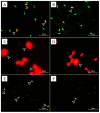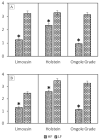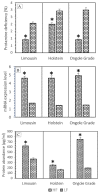PRM1 Gene Expression and Its Protein Abundance in Frozen-Thawed Spermatozoa as Potential Fertility Markers in Breeding Bulls
- PMID: 35324839
- PMCID: PMC8951773
- DOI: 10.3390/vetsci9030111
PRM1 Gene Expression and Its Protein Abundance in Frozen-Thawed Spermatozoa as Potential Fertility Markers in Breeding Bulls
Abstract
Functional genes and proteins in sperm play an essential role in bulls’ reproductive processes. They are more accurate in determining bull fertility than conventional semen quality tests. Protamine-1 (PRM1) is a gene or protein crucial for packaging and protecting sperm DNA until fertilization affects normal sperm function. This study analyzes the genes and proteins potential from PRM1 as fertility markers for different breeds of bulls utilized in the artificial insemination programs, expected to be an accurate tool in interpreting bull fertility in Indonesia. This study used Limousin, Holstein, and Ongole Grade bulls divided into two groups based on fertility, high-fertility (HF) and low fertility (LF). The semen quality assessment included progressive motility (computer-assisted semen analysis), viability (eosin-nigrosine), and plasma membrane integrity (HOS test). Sperm DNA fragmentation (SDF) was assessed using the acridine orange staining and the Halomax test. Sperm PRM deficiency was evaluated with the chromomycin A3 method. Moreover, PRM1 gene expression was measured using qRT-PCR, and the PRM1 protein abundance was measured with the enzyme immunoassay method. Semen quality values, relative expression of PRM1 gene, and quantity of PRM1 protein were significantly higher (p < 0.05) in HF bulls than in LF bulls. The SDF and PRM deficiency values in LF bulls were significantly higher (p < 0.05) than HF bulls. Additionally, PRM1 at the gene and protein levels correlated significantly (p < 0.01) with fertility. Therefore, PRM1 is a potential candidate for fertility markers in bulls in Indonesia.
Keywords: breeding bulls; fertility marker; frozen-thawed spermatozoa; gene expression; protamine-1; protein abundance.
Conflict of interest statement
The authors declare no conflict of interest.
Figures




Similar articles
-
Identification of heat shock protein70-2 and protamine-1 mRNA, proteins, and analyses of their association with fertility using frozen-thawed sperm in Madura bulls.Anim Biosci. 2023 Dec;36(12):1796-1805. doi: 10.5713/ab.23.0142. Epub 2023 Jun 26. Anim Biosci. 2023. PMID: 37402446 Free PMC article.
-
The potential of sperm bovine protamine as a protein marker of semen production and quality at the National Artificial Insemination Center of Indonesia.Vet World. 2021 Sep;14(9):2473-2481. doi: 10.14202/vetworld.2021.2473-2481. Epub 2021 Sep 23. Vet World. 2021. PMID: 34840468 Free PMC article.
-
Sperm protamine-status correlates to the fertility of breeding bulls.Biol Reprod. 2015 Apr;92(4):92. doi: 10.1095/biolreprod.114.124255. Epub 2015 Feb 11. Biol Reprod. 2015. PMID: 25673563
-
Current status of sperm functional genomics and its diagnostic potential of fertility in bovine (Bos taurus).Syst Biol Reprod Med. 2018 Dec;64(6):484-501. doi: 10.1080/19396368.2018.1444816. Epub 2018 Mar 14. Syst Biol Reprod Med. 2018. PMID: 29537884 Review.
-
Breeding soundness evaluation and semen analysis for predicting bull fertility.Reprod Domest Anim. 2008 Jul;43 Suppl 2:368-73. doi: 10.1111/j.1439-0531.2008.01186.x. Reprod Domest Anim. 2008. PMID: 18638148 Review.
Cited by
-
Identification of heat shock protein70-2 and protamine-1 mRNA, proteins, and analyses of their association with fertility using frozen-thawed sperm in Madura bulls.Anim Biosci. 2023 Dec;36(12):1796-1805. doi: 10.5713/ab.23.0142. Epub 2023 Jun 26. Anim Biosci. 2023. PMID: 37402446 Free PMC article.
-
Polymorphism detection and characterization of sperm cells chromatin remodeling associated genes in Murrah buffalo.Trop Anim Health Prod. 2024 Oct 2;56(8):318. doi: 10.1007/s11250-024-04158-w. Trop Anim Health Prod. 2024. PMID: 39356339
-
Sperm Head Morphology Alterations Associated with Chromatin Instability and Lack of Protamine Abundance in Frozen-Thawed Sperm of Indonesian Local Bulls.Animals (Basel). 2023 Jul 27;13(15):2433. doi: 10.3390/ani13152433. Animals (Basel). 2023. PMID: 37570242 Free PMC article.
-
Sperm Transcriptome Analysis Accurately Reveals Male Fertility Potential in Livestock.Animals (Basel). 2022 Oct 27;12(21):2955. doi: 10.3390/ani12212955. Animals (Basel). 2022. PMID: 36359078 Free PMC article. Review.
-
Bovine sperm HSP-70 molecules: a potential cryo-tolerance marker associated with semen quality and fertility rate.Front Vet Sci. 2023 Aug 9;10:1167594. doi: 10.3389/fvets.2023.1167594. eCollection 2023. Front Vet Sci. 2023. PMID: 37621869 Free PMC article.
References
-
- Pardede B.P., Supriatna I., Yudi Y., Agil M. Decreased bull fertility: Age-related changes in sperm motility and DNA fragmentation. E3S Web Conf. 2020;151:01010. doi: 10.1051/e3sconf/202015101010. - DOI
-
- BSN . National Standardization of Bull Frozen Semen Part 1. SNI No. 4869.1. Badan Standardisasi Nasional; Central Jakarta, Indonesia: 2017.
Grants and funding
LinkOut - more resources
Full Text Sources
Research Materials
Miscellaneous

